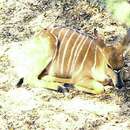en
names in breadcrumbs


Perception Channels: tactile ; chemical
Nyala currently have a more limited distribution than they have had in the past. Recently in some areas their habitat has actually been improved through human activities, such as shifting agricultural techniques resulting in abandonment of fields and subsequent bush encroachment, and overgrazing of grasslands by cattle, which results in invasion by many herbs that nyala eat.
US Federal List: no special status
CITES: no special status
IUCN Red List of Threatened Species: least concern
These antelopes have probably historically been hunted as food animals.
Positive Impacts: food
These antelope both graze and browse. They eat the leaves, twigs, flowers and fruits of many different species of plants. During the rainy season they mainly eat the fresh green grass. They drink daily when water is available, but they can survive in areas where water is only available seasonally.
Nyala have a localized distribution, occupying some parts of southeastern Africa.
Biogeographic Regions: ethiopian (Native )
Nyala are found near thickets in dry savanna woodland, and prefer proximity to high quality grassland and fresh water as well.
Terrestrial Biomes: savanna or grassland ; scrub forest
Average lifespan
Status: captivity: 18.5 years.
Nyala are medium sized in comparison to other antelopes, with a marked size difference between the sexes. Males weigh 98-125 kg and stand over one meter tall at the shoulder, while females weigh 55-68 kg and are slightly less than a meter tall. Males have horns, which can be up to 80 cm long and spiral upwards, curving out at the first turn. Females and juveniles are usually a rusty red color, but adult males become slate gray. Both males and females have a dorsal crest of long hair that runs from the back of the head to the base of the tail, and males additionally have a fringe of long hair along the midline of their chest and belly. Nyala have some white vertical stripes and spots, the pattern of which varies.
Range mass: 55 to 126 kg.
Other Physical Features: endothermic ; bilateral symmetry
Nyala can breed at any time of the year, but there is a breeding peak in the spring and a smaller peak in the autumn. A female's estus cycle is about 19 days long. Males court females for two days of this cycle, but females are receptive to mating for only 6 hours per cycle. Gestation takes 7 months, after which a single, 5 kg calf is born. The young are born out of the sight of potential predators (lions, hyenas, leopards, wild dogs) in a thicket. A calf remains hidden for up to 18 days, during which time the mother returns periodically to clean and nurse it. Offspring remain with their mothers until her next calf is born, but after that courting males drive adolescent males away from their mothers.
Range number of offspring: 1 to 2.
Average number of offspring: 1.
Range gestation period: 7.33 to 8.4 months.
Average weaning age: 7 months.
Key Reproductive Features: gonochoric/gonochoristic/dioecious (sexes separate); sexual
Average birth mass: 5232.5 g.
Average number of offspring: 1.
Average age at sexual or reproductive maturity (female)
Sex: female: 452 days.
Parental Investment: altricial ; post-independence association with parents